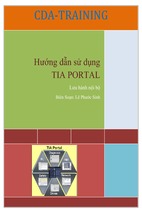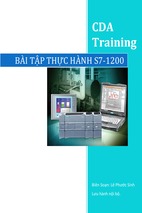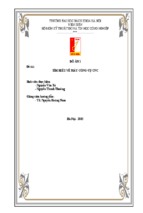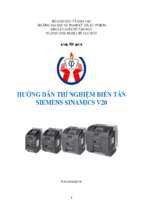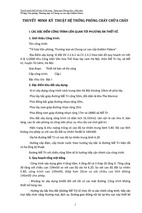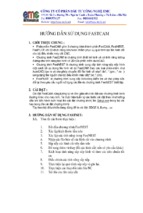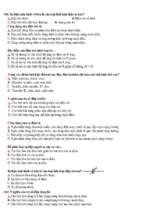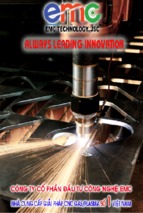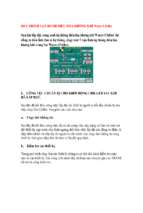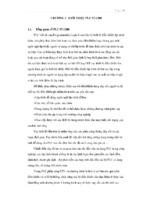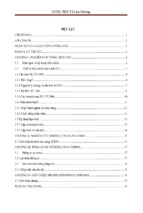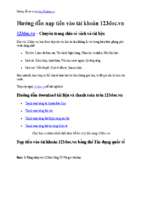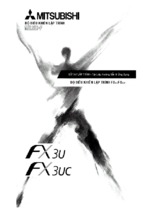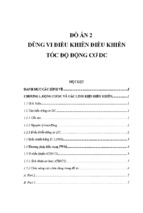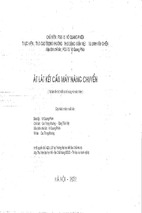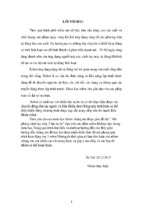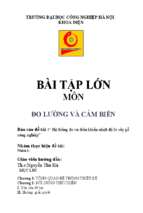Mô tả:
Comparing and Estimating
Work and Time Studies
Vietnamese German University
Dr.-Ing. Marlene Helfert
2016
Dr.-Ing. Marlene Helfert | Work and Time Studies | 2016 | 1
Comparing and estimating
Contents
Comparing and estimating
Methods of comparing and estimating
Procedure of comparing and estimating
Dr.-Ing. Marlene Helfert | Work and Time Studies | 2016 | 2
Comparing and estimating
Comparing and estimating
Method of work data determination
Can lead to sufficiently accurate results when other, more
precise values are not available, e.g. in work situations where
the application of the time recording or other data acquisition
methods is too costly or impossible due to short notice
Procedure
The work situations in question are compared with already
known ones and their times are estimated with appropriate
adjustments
REFA 2013
Dr.-Ing. Marlene Helfert | Work and Time Studies | 2016 | 3
Comparing and estimating
Comparing
Juxtaposition of facts to determine differences or similarities
The time difference between the same or similar process
sections, is taken into account by increasing or reducing the
available values. These increases and reductions can be
determined with time studies, using target times or by
estimating.
Estimating
Approximate determination of quantitative data
The target time for the process sections is determined by
memory or experience: An expert estimates how much time is
needed for the execution of this work
REFA 2013
Dr.-Ing. Marlene Helfert | Work and Time Studies | 2016 | 4
Comparing and estimating
Before estimating comes comparing
Estimating without comparing corresponds to an estimate
without any benchmark, which does generally not result in
sufficiently accurate values
Even in supposedly completely new situations, there are
benchmarks, experiences, etc. as a guide when estimating
REFA 2013
Dr.-Ing. Marlene Helfert | Work and Time Studies | 2016 | 5
Comparing and estimating
Human perception of time
Estimating is always subjective, because it depends
on the person guessing and his or her experience and
knowledge.
REFA 2013
Dr.-Ing. Marlene Helfert | Work and Time Studies | 2016 | 6
Comparing and estimating
Human perception of time
Man has no inherent “sense of time”
Sense of time depends on experience, that is affected by
the number and type of events that we experienced within
a certain time
We can estimate time periods only by comparison
Setup times are usually overestimated
Set-up provides a relatively high level of experience and
content variety and therefore appears often longer
Times for scheduled operations with a high proportion of
monitoring and workflow-related interruption times are
usually understated
Such processes have a low content of experience and offer
little variety
REFA 2013
Dr.-Ing. Marlene Helfert | Work and Time Studies | 2016 | 7
Comparing and estimating
Comparison of work pieces
In practice, work pieces, which are processed by the same or
similar work processes, are juxtaposed and compared.
By comparison of the shape, the dimensions and the material
of the to be produced work piece with already made similar
work objects, the same or different process sections can be
determined.
REFA 2013
Dr.-Ing. Marlene Helfert | Work and Time Studies | 2016 | 8
Methods of comparing and estimating
Methods of comparing and estimating
Summary comparing and estimating
Subdivided comparing and estimating
Interval estimating
REFA 2013
Dr.-Ing. Marlene Helfert | Work and Time Studies | 2016 | 9
Methods of comparing and estimating
Summary comparing and estimating
Deals only with the entire process as a whole: As an overall
process, e.g. the production of a cabinet door is understood.
It takes 72 seconds to mount a
trolley with four wheels. How long
will it take to produce a trolley with
only three wheels?
REFA 2013
Dr.-Ing. Marlene Helfert | Work and Time Studies | 2016 | 10
Methods of comparing and estimating
Subdivided comparing and estimating
Combines the estimation with the analytical approach of the
work process breakdown into smaller process sections
Procedure
Divide the entire process into manageable sections
Estimate the times for each of these sections
Add the individual times to a total time
Advantages
More accurate results
In short process sections the influence factors are more
evident than in longer ones
For smaller process sections, comparative data for
verification can be more easily found
Estimation errors partly balance each other: The estimation
error decreases with the number of the estimated values
REFA 2013
Dr.-Ing. Marlene Helfert | Work and Time Studies | 2016 | 11
Methods of comparing and estimating
Subdivided comparing and estimating
Lay frame on the table
and put 4 wheel frames
on frame
8 sec
Mount wheel 1
12 sec
Mount wheel 2
12 sec
Mount wheel 3
12 sec
Mount wheel 4
12 sec
Bring trolley to storage
16 sec
Please use subdivided
comparing to assess
how many seconds
will be needed to
produce a threewheel-trolley!
Dr.-Ing. Marlene Helfert | Work and Time Studies | 2016 | 12
Methods of comparing and estimating
Interval estimate
Instead of point estimates (e.g. "It takes 12 minutes.") experts
can also carry out estimations in the form of interval estimates
(e.g. "It takes between 10 and 15 minutes.")
The average value of the time class which has been indicated
by the expert is used as an estimate
Interval time catalogues
Base of interval estimates
Consist of time classes whose margins increase by a certain
law. Each class has:
A time class lower limit
A time class upper limit
A time class mean
DMTM 2016
REFA 2013
Dr.-Ing. Marlene Helfert | Work and Time Studies | 2016 | 13
Procedure of comparing and estimating
1
Describe task, define usage of data
2
Search similar work piece in comparison documents
3
Compare execution conditions
4
Examine deviations of work pieces
5
Examine deviations of processes
6
Determine times for additional or omitted process sections
7
Determine and add allowances and recovery supplements
8
Confirm and use target time
REFA 2013
Dr.-Ing. Marlene Helfert | Work and Time Studies | 2016 | 14
Procedure of comparing and estimating
Work system description
Accuracy is defined by usage
1
Describe task, define usage of data
2
Search similar work piece in comparison documents
3
Compare execution conditions
4
Examine deviations of work pieces
5
Examine deviations of processes
6
Determine times for additional or omitted process sections
7
Determine and add allowances and recovery supplements
8
Confirm and use target time
REFA 2013
Dr.-Ing. Marlene Helfert | Work and Time Studies | 2016 | 15
Procedure of comparing and estimating
From comparison
documents, e.g.
drawings, work
schedules, time
classes catalogue
1
Describe task, define usage of data
2
Search similar work piece in comparison documents
3
Compare execution conditions
4
Examine deviations of work pieces
5
Examine deviations of processes
6
Determine times for additional or omitted process sections
7
Determine and add allowances and recovery supplements
8
Confirm and use target time
A sufficiently large
number of
comparable process
elements and times
for similar work
tasks, workpieces,
work procedures and
working methods is
needed.
The workflow needs
to be adequately
described
REFA 2013
Dr.-Ing. Marlene Helfert | Work and Time Studies | 2016 | 16
Procedure of comparing and estimating
E.g. frequency of
occurrence, material
resources to use
1
Describe task, define usage of data
2
Search similar work piece in comparison documents
3
Compare execution conditions
4
Examine deviations of work pieces
5
Examine deviations of processes
6
Determine times for additional or omitted process sections
7
Determine and add allowances and recovery supplements
8
Confirm and use target time
Important
Production
technologies and
lot sizes are
known for both
work items
Equipment used
for both work
objects is
comparable
Material is known
and can be REFA 2013
differentiated
Dr.-Ing. Marlene Helfert | Work and Time Studies | 2016 | 17
Procedure of comparing and estimating
1
Describe task, define usage of data
2
Search similar work piece in comparison documents
3
Compare execution conditions
4
Examine deviations of work pieces
5
Examine deviations of processes
6
Determine times for additional or omitted process sections
7
Determine and add allowances and recovery supplements
8
Confirm and use target time
To be compared
processes need to be
defined and
described.
Differences must be
clarified, e.g.
dimensions or shape
of the work object
REFA 2013
Dr.-Ing. Marlene Helfert | Work and Time Studies | 2016 | 18
Procedure of comparing and estimating
Comparison shows
similarities and differences:
Are all process sections
of the known work still
needed?
Will new process
elements be added?
Will process sections
change?
1
Describe task, define usage of data
2
Search similar work piece in comparison documents
3
Compare execution conditions
4
Examine deviations of work pieces
5
Examine deviations of processes
6
Determine times for additional or omitted process sections
7
Determine and add allowances and recovery supplements
8
Confirm and use target time
Time needed for each
process section can be
estimated or calculated by
taking into account the
REFA 2013
influence factors
Dr.-Ing. Marlene Helfert | Work and Time Studies | 2016 | 19
Procedure of comparing and estimating
1
Describe task, define usage of data
2
Search similar work piece in comparison documents
3
Compare execution conditions
4
Examine deviations of work pieces
5
Examine deviations of processes
6
Determine times for additional or omitted process sections
7
Determine and add allowances and recovery supplements
8
Confirm and use target time
Estimate the time
required for
additional and
omitted process
sections by
comparison with
known values,
• e.g. standard
time elements
• experience
• time studies for
individual
process sections
and summarize
values
REFA 2013
Dr.-Ing. Marlene Helfert | Work and Time Studies | 2016 | 20
- Xem thêm -

